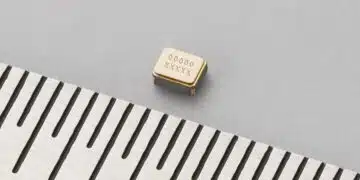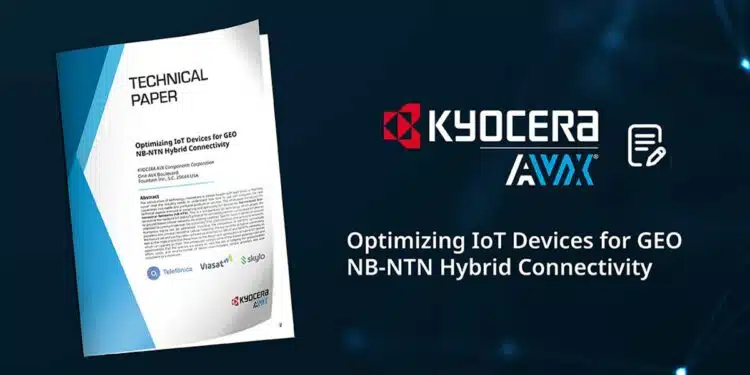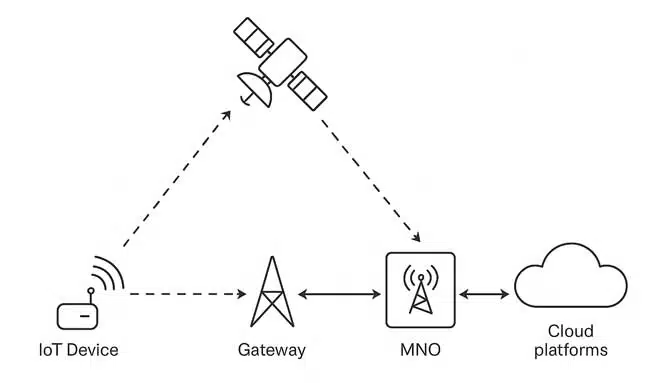KYOCERA AVX has released white paper Optimizing IoT Devices for GEO NB-NTN Hybrid Connectivity written in collaboration with Telefonica, Viasat, & Skylo.
Abstract
The introduction of technology innovations inevitably involves lead times and a “learning curve” that the industry must comprehend to effectively utilize and integrate new capabilities into viable and profitable products or services. This whitepaper delves into the technical aspects of designing and optimizing IoT devices for Narrow-Band Non-terrestrial Networks (NB-NTN). NB-NTN is a standardized 5G technology that adapts the terrestrial Narrow-Band IoT (NB-IoT) protocol to connect remote, constrained IoT devices to ground-based cellular networks via orbiting satellites.
The paper focuses on services intended to communicate over Geostationary Orbit (GEO) satellites and terrestrial networks. It covers various topics, including the integration of NB-NTN connectivity providers into classical terrestrial cellular networks, the key benefits of hybrid connectivity, the feature set and configuration differences between terrestrial NB-IoT and NB-NTN networks, and the implications these have on the design and optimization of hybrid IoT devices that can operate on both.
The whitepaper also acknowledges known potential risks and opportunities, aiming to minimize the productization effort, costs, and time-to-market for device manufacturers, service providers, and end-customers. Special focus is placed on antenna design, modem selection, power architecture, and regulatory compliance.
1. Introduction
Traditional NB-IoT networks fall short in reaching maritime, rural, and infrastructure-poor regions. GEO-based NB-NTN offers a solution by enabling narrowband communication from orbit. Defined in 3GPP Release 17, NB-NTN enhances coverage while maintaining compatibility with NB-IoT device ecosystems. This hybrid model merges terrestrial fallback with satellite resilience.
2. System Architecture Overview
2.1 GEO Satellite Connectivity
GEO NB-NTN involves a bent-pipe satellite relay system interfacing with mobile network operators (MNOs):
- Fixed satellite position enables simplified tracking
- Round-trip latency ~250 ms
- Uplink budget limited to 23 dBm for Power Class 3 devices
- Integration via standard S1 and S8 interfaces at MNO edge
3. Antenna Engineering for Hybrid Operation
3.1. Performance Role in System Link Budget
The antenna subsystem critically influences the NB-NTN link performance, particularly due to high free-space path loss (~190+ dB) and atmospheric impairments. Unlike multipath-rich terrestrial NB-IoT, GEO satellites rely on line-of-sight propagation, minimizing angular spread but demanding stricter elevation and polarization control.
3.2. Selection and Design Guidelines
Key selection factors for antenna systems in hybrid NB-NTN/NB-IoT devices:
- Multiband operation: Support for both terrestrial (e.g., B20) and satellite (e.g., L-/S-Band)
- Efficiency > 60% in satellite bands under ground-level orientation
- VSWR ≤ 2:1 across bands to minimize mismatch losses
- Radiation pattern: Omnidirectional for GNSS and terrestrial fallback; more directive for satellite reception
External antennas are recommended where form factor allows, as internal PCB-integrated solutions often underperform under low-elevation GEO link constraints. When space or design demands internalization, high-Q multiband ceramic elements may be used with proper ground plane tuning.
3.3. Integration Best Practices
- Use short RF feedlines (<10 cm) to reduce insertion loss
- Apply matching networks with π or T topologies customized per band
- Isolate GNSS and NB-NTN paths if operating concurrently
4. Hardware Considerations in IoT NB-NTN Device Design
4.1. Battery Technologies
NB-NTN imposes periodic current bursts (up to 23 dBm TRP) which constrain battery selection. Two chemistries are suited for harsh outdoor and long-lifetime deployments:
- Li-SOCl₂: High energy density, low self-discharge, robust pulse support with capacitive buffer
- Li-MnO₂: High discharge current capability, compact form factors
Spiral-wound cells are preferred for pulse tolerance, while bobbin cells offer higher energy density but require pulse-support components (e.g., EDLCs).
4.2. Modem & Certification
Use of Skylo or Viasat-certified NB-NTN modules ensures compliance. Multimode modules (NB-NTN + NB-IoT) reduce SKU complexity and optimize BOM costs. Certification processes may vary by MNO, with Telefónica Germany offering integrated NB-NTN SIM solutions through its Kite platform.
5. Network and Regulatory Integration
5.1. Roaming Framework
NB-NTN networks integrate into MNO infrastructure via 3GPP roaming agreements, allowing devices to use a single SIM for terrestrial and satellite domains. Control and data planes remain consistent, with traffic securely home-routed through standard interfaces like S8-C.
5.2. Spectrum Licensing
Although the satellite spectrum (e.g., L-band) is allocated globally, country-specific landing rights are required. Service providers must negotiate access with national regulators. Coverage in polar/high-latitude regions may be limited due to GEO satellite visibility.
6. Conclusion
Designing IoT devices for NB-NTN hybrid connectivity requires a system-level engineering approach that balances link budget constraints, hardware integration, spectrum compliance, and network interoperability. Antenna architecture is the central determinant of NB-NTN feasibility, especially for devices with compact form factors or diverse deployment environments. Proper pairing with power supply technologies, certified modules, and regulatory-aware deployments ensures the long-term viability of NB-NTN in real-world IoT scenarios.
Read the full white paper here: https://www.kyocera-avx.com/docs/techinfo/Antennas/Optimizing-IoT-Devices-GEO-NB-NTN-Hybrid-Connectivity.pdf






























